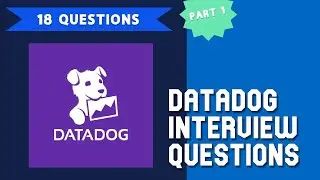DataDog Knowledge Quiz. 18 Interview Questions
https://go.webula.ch/5lkB0s - Monitor and control everything your children do on the computer!
https://go.webula.ch/CB7uQb - A tool designed to detect AI written text and make AI-generated content more human.
https://go.webula.ch/EWfjZX - Parallels - run Windows on your Mac
DatDog knowledge questions that many programmers have to answer at interviews. Even experienced professionals fail it. Check your level and write in the comments if it was difficult for you.
#datadog #test #quiz
Datadog is a monitoring and analytics platform that provides comprehensive visibility into the performance of an organization's applications, infrastructure, and services. It offers a range of tools and features to monitor, troubleshoot, and optimize various aspects of a system, including metrics, logs, and traces.
Here are some key features of Datadog:
1. Monitoring: Datadog allows you to collect and visualize metrics from various sources, such as servers, databases, containers, and cloud providers. It provides real-time monitoring and alerting based on predefined thresholds or anomaly detection.
2. Infrastructure Monitoring: Datadog can monitor the health and performance of infrastructure components, including servers, virtual machines, networks, and cloud services. It offers integrations with popular technologies and platforms to gather metrics and events for analysis.
3. Application Performance Monitoring (APM): Datadog's APM solution enables you to monitor and optimize the performance of your applications. It provides detailed insights into code-level performance, latency, error rates, and user experience. It supports various programming languages and frameworks.
4. Log Management: Datadog allows you to collect, aggregate, and analyze logs from different sources, making it easier to troubleshoot issues and identify trends. It offers search and filtering capabilities, as well as integration with other monitoring data for correlation.
5. Real User Monitoring (RUM): Datadog provides RUM capabilities to measure the performance and user experience of web applications. It collects data from users' browsers and provides insights into page load times, AJAX requests, and other metrics.
6. Collaboration and Visualization: Datadog offers dashboards and visualizations to help teams collaborate and gain insights from monitoring data. It supports custom dashboards, alerting, and reporting, allowing teams to share information and track key metrics.
7. Integration Ecosystem: Datadog has a wide range of integrations with popular technologies, including cloud providers, databases, orchestration tools, and more. This allows you to centralize your monitoring and observability data in a single platform.
Overall, Datadog is widely used by DevOps teams, developers, and IT professionals to gain deep insights into their systems and improve the performance, reliability, and scalability of their applications and infrastructure.



















